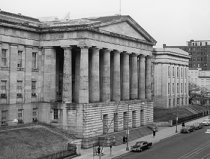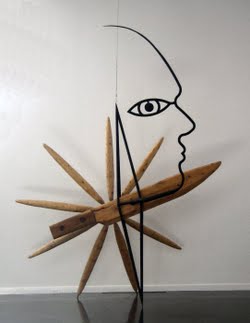American Art Museum, Washington, DC
The Smithsonian American Art Museum is dedicated to the art and artists of the United States. All regions, cultures, and traditions in this country are represented in the museum's collections, research resources, exhibitions, and public programs. Colonial portraiture, nineteenth-century landscape, American impressionism, twentieth-century realism and abstraction, New Deal projects, sculpture, photography, prints and drawings, contemporary crafts, African American art, Latino art, and folk art are featured in the collection. More than 7, 000 American artists are represented, including major artists such as John Singleton Copley, Winslow Homer, John Singer Sargent, Childe Hassam, Georgia O'Keeffe, Edward Hopper, Jacob Lawrence, Robert Rauschenberg, Nam June Paik, and Martin Puryear.
History of the Collection
The collection began modestly in 1829 when a Washingtonian named John Varden set out to form a museum in the nation's capital for his collection of European art. At first, the art was placed in a room he added to his own house near the U.S. Capitol.
In 1841, Varden's collection was displayed in the newly constructed Patent Office Building—coincidentally, the museum's home today. Along with Varden's works came Varden himself as "curator" of the newly created "National Institute" for government-owned artistic and historic items. Paintings and sculptures shared space in a large exhibit hall with the Declaration of Independence and Benjamin Franklin's printing press.
The establishment of the Smithsonian in 1846 eclipsed the prestige of the institute, which later disbanded. By 1858, a majority of the items on view at the Patent Office Building were moved a few blocks to the newly completed Smithsonian Castle. The remainder of the collection followed in 1862. But a destructive fire there in 1865 increased the Smithsonian's reluctance to build cultural collections. For the rest of the century, most of the artwork was placed on loan to the Library of Congress and to the Corcoran Gallery of Art.
A Turning Point
A turning point in the history of the collection came in 1906. That year the probated will of Harriet Lane Johnston, an art collector and niece of President James Buchanan, forced an important decision in a federal court: the recognition that the Smithsonian's collection formed a "National Gallery of Art."
A Permanent Home

Plans to build a permanent home for the museum on the National Mall came and went, among them a prize-winning modernist structure that shocked federal officials and was never built. The competition had been organized after Andrew Mellon gave his European-focused art collection to the nation in 1937 with the stipulation that his new museum be called the "National Gallery of Art" in emulation of the National Gallery of Art in London.
To comply with Mellon's wishes for a National Gallery of Art to house his European collection, the Smithsonian museum known as the National Gallery of Art for thirty-one years was renamed the National Collection of Fine Arts in 1937. It assumed new responsibilities in promoting the work of living artists and building a national audience.
You might also like







 James Surls (born April 19, 1943) is an American modernist artist. He earned a BS from Sam Houston State University and an MFA from the Cranbrook Academy of Art. In 1998, he moved from Splendora, Texas to Carbondale, Colorado.
James Surls (born April 19, 1943) is an American modernist artist. He earned a BS from Sam Houston State University and an MFA from the Cranbrook Academy of Art. In 1998, he moved from Splendora, Texas to Carbondale, Colorado.